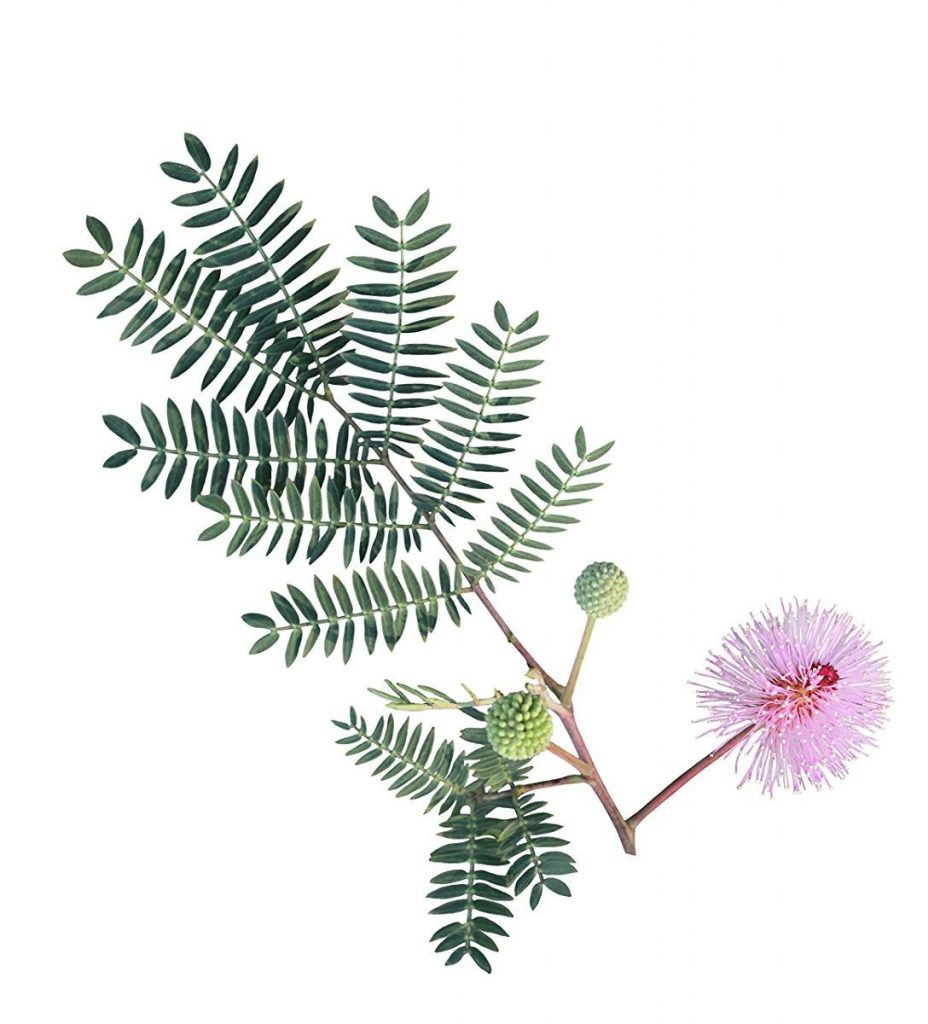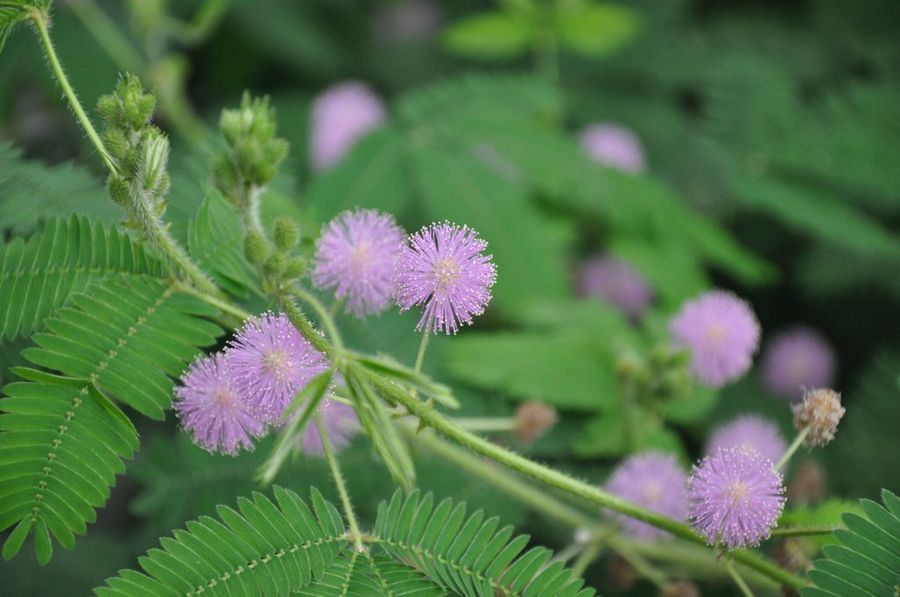Mimosa Plant Summary
Scientific Name: Mimosa pudica
Other Names: Touch me not, Live and Die, Shame Plant, Humble Plant
Habitat: Africa, Caribbean, Tropical America and Australia, also found in India. Commonly distributed in open-spaces, especially road side, cultivated land, and waste area.
Description: Has recurved thorns and with sensitive soft grey green leaflets that fold and droop at night or when touched and cooled.

Action
Regeneration of sciatica, anti-depressant, anti-convulsant, hyperglycemic, anti-microbial, anti-fungal, ‘anti-viral’, aphrodisiac, anti-fertility
Traditional Uses
The plant is beneficial in hemorrhagic diseases, diarrhea, and gynecological disorders. It has been used in the treatment of urogenital disorders, piles, dysentery, sinus, and also applied on cuts and wounds. Rheumatism, stiff knee, lancinating pains in back and limbs, swelling of ankles, legs tremble. It is also used for childbirth and infertility in Trinidad and Tobago. Bath with plant decoction relieves insomnia. The leaves are used for hydrocele, dressing for sinus, sores, piles and swelling of feet. In Mexico, aqueous extracts from dried leaves are employed to alleviate depression. In the Philippines, the leaves soaked in coconut oil is used for ulcers.
Root: Used to control dipsomania (alcoholism) in Surinam.
Stem and Leaf: Infusion used to sharpen the sense of smell in French Guiana hunting dogs. Decoction is efficacious in gravel and other urinary complaints. Treats dysentery, fever, syphilis, leprosy, stomach worms, veneral diseases, insect bite, insomnia, nervousness, and pile.
Leaves: In Surinam, an alcoholic extract is given to remedy drunkenness. For a mild sudorific (cause sweating); infusion is tonic, bitter. The leaves together with leaves from other medicinal plants are used in treating hemorrhoids and urinary infections.
Juice: The juice is used in sinus, sores, piles, and fistula
Seed: Emetic.
Paste: Paste is applied to glandular swellings, hydrocele, wounds.
Study Information
Regeneration of sciatic nerve: An extract administered in a dose of 1.6 mg/100 g parenterally every 4th day up to 120 days in rats having experimental injury of sciatic nerve, exhibited 30–40% higher results in the process of regeneration of sciatic nerve as compared to the hydrocortisone group.
Antidepressant action: In Mexico, aqueous extracts from dried leaves of M. pudica are used to alleviate depression. In a study, behavioral actions of aqueous extracts of M. pudica at various concentrations were tested. The data indicated that M. pudica produces antidepressant effects in the rat.
Anticonvulsant action: The decoction of M. pudica leaves given intraperitoneally at a dose of 1000–4000 mg/kg protected mice against pentylenetetrazole and strychnine-induced seizures. M. pudica had no effect against picrotoxin-induced seizures.
Hyperglycemic effect: Ethanolic extracts of M. pudica leaves given by oral route to mice at a dose of 250 mg/kg showed a significant hyperglycemic effect.
Diuretic effect: Decoction of leaves of M. pudica in doses of 200, 500, 1000, and 2000 mg/kg in rats and dogs exhibited diuretic activity. The activity in rats at 250 mg/kg dose was found to be 82% of standard diuretic (hydrochlorthiazide 2.5 mg/kg) treated group of rats. There was significant reduction (above 50%) of Na+ and Cl- excretion without affecting K+ excretion.
Effect on uterine bleeding: Aqueous extracts of the root powder in pilot studies on patients with dysfunction uterine bleeding gave promising results.
Spasmogenetic potential: Ethanol extracts (50%) of the whole plant exhibited spasmogenetic activity in isolated guinea pig ileum.
Antifungal activity: The methanolic extract and aqueous extract of 100, 200, and 500 mg were tested against different fungal pathogens, Aspergillus fumigates for their antifungal activity. It was demonstrated by a well diffusion assay.
Antimicrobial properties: Four of the seven tested medicinal plants exhibited antimicrobial activity against Vibrio cholerae. These seven plants are: Ficus capensis, Mitragyna stipulosa, Entada Africana, Piliostigma reticulatum, Terminalia avicennoides, M. pudica, and Lannea acid. M. pudica showed antimicrobial activity.
Wound healing activity: The roots of M. pudica were studied for wound healing activity by incorporating the methanolic and the total aqueous extracts in simple ointment base B.P. in concentration of 0.5% (w/w), 1% (w/w), and 2% (w/w). Wound healing activity was studied in three types of model in rats viz. excision, incision, and estimation of biochemical parameters. Treatment of wound with ointment containing 2% (w/w) the methanolic and 2% (w/w) the total aqueous extract exhibited significant (P < 0.001) wound healing activity. The methanolic extract exhibited good wound healing activity probably due to phenols constituents
Contraindication
Root: Vomitive, irritant; toxic in large dosage.
Part(s) Used
Whole plant, leaves, and roots.
Dosage
Dose: Take 2 capsules twice daily on an empty stomach or as otherwise directed by an experienced herbalist. 50-100 ml divided into 2-3 doses for the days. 10-20 ml of fresh juice
For specifics ailments:
Urinary problems: 40-50 ml of decoction.
Menorrhagia: 15-20 ml of decoction two times daily.
Vaginal prolapse: Make poultice and apply to the area.
Bleeding piles, diarrhea: 20 ml three times daily.
A paste of the plant is applied to cut and skin disease
Dose dependent antidiabetic effect of Mimosa pudica leaves extract in type 2 diabetic rat model
 Loading...
Loading...
Mimosa- A brief overview
 Loading...
Loading...
Mimosa pudica L. (Laajvanti): An overview
 Loading...
Loading...
Reference(s)
Medicinal Plants of the Guianas (Guyana, Surinam, French Guiana)
Mimosa pudica L. (Laajvanti): An overview
easyayurveda.com
This article is copyrighted by Ital is Vital, 2025. Want to re-post this article? Visit our guidelines.
DISCLAIMER: THIS WEBSITE DOES NOT PROVIDE MEDICAL ADVICE
The information, including but not limited to, text, graphics, images and other material contained on this website are for informational purposes only. The purpose of this website is to promote broad consumer understanding and knowledge of various health topics. It is not intended to be a substitute for professional medical advice, diagnosis or treatment. Always seek the advice of your physician or other qualified health care provider with any questions you may have regarding a medical condition or treatment and before undertaking a new health care regimen, and never disregard professional medical advice or delay in seeking it because of something you have read on this website.
